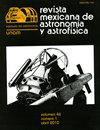在远离大质量引力中心的湍流气体云中嵌入不等双子星碰撞的模拟
IF 1.7
4区 物理与天体物理
Q3 ASTRONOMY & ASTROPHYSICS
Revista Mexicana de Astronomia y Astrofisica
Pub Date : 2022-04-06
DOI:10.22201/ia.01851101p.2022.58.02.09
引用次数: 0
摘要
我们模拟一个湍流气体云的坍缩,其中我们选择了两个子云。加上平移速度$\vec{r}_L$或$\vec{r}_R$,使子云相互移动以发生碰撞。选择子云的半径和碰撞前速度不等,并考虑正面和斜向碰撞。所有的模拟都被校准为具有相同的总质量和初始能量比α = 0.16,定义为热能与引力能之比。我们比较了低-β模型和高-β模型,其中β被定义为动能与引力能的比值。最后,我们认为湍流云受到距离足够远的物体的引力影响,以便除了上述的平动速度和湍流速度外,通过添加到云粒子的方位角速度Vcir来近似潮汐效应。我们比较了低vcir模型和高vcir模型。本文章由计算机程序翻译,如有差异,请以英文原文为准。
SIMULATIONS OF UNEQUAL BINARY COLLISIONS EMBEDDED IN A TURBULENT GAS CLOUD FAR FROM A MASSIVE GRAVITATIONAL CENTER
We simulate the collapse of a turbulent gas cloud, in which we choose two sub-clouds. A translational velocity $\vec{r}_L$ or $\vec{r}_R$ is added, so that the sub-clouds move towards each other to collide. The radius and pre-collision velocity of the sub-clouds are chosen to be unequal, and both head-on and oblique collisions are considered. The simulations are all calibrated to have the same total mass and initial energy ratio α = 0.16, which is defined as the ratio of thermal energy to gravitational energy. We compare low-β models to a high-β models, where β is defined as the ratio of kinetic energy to gravitational energy. Finally, we consider the turbulent cloud to be under the gravitational influence of an object located far enough, in order to approximate the tidal effects by means of an azimuthal velocity Vcir added to the cloud particles apart from the translational and turbulent velocities mentioned above. We compare a low-Vcir model with a high-Vcir one.
求助全文
通过发布文献求助,成功后即可免费获取论文全文。
去求助
来源期刊

Revista Mexicana de Astronomia y Astrofisica
地学天文-天文与天体物理
CiteScore
1.30
自引率
10.00%
发文量
14
审稿时长
>12 weeks
期刊介绍:
The Revista Mexicana de Astronomía y Astrofísica, founded in 1974, publishes original research papers in all branches of astronomy, astrophysics and closely related fields. Two numbers per year are issued and are distributed free of charge to all institutions engaged in the fields covered by the RMxAA.
 求助内容:
求助内容: 应助结果提醒方式:
应助结果提醒方式:


